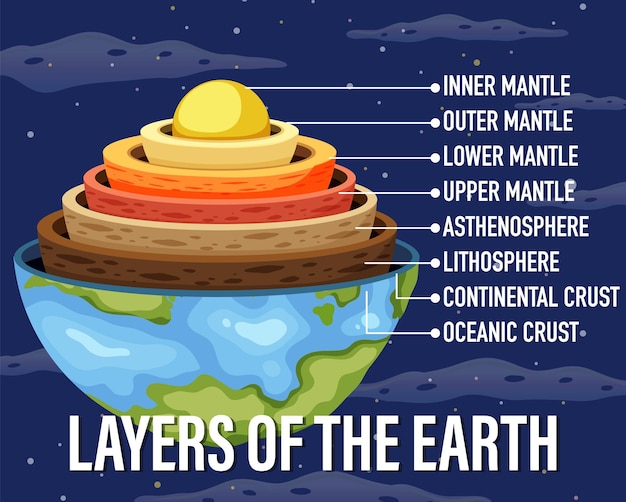Interesting Facts about Earth’s Crust

The Earth’s crust is the thin outer layer that forms the planet’s surface.
The average thickness of the Earth’s crust is about 35 kilometers.
The Earth’s crust is made up of several types of rocks, including basalt, granite, and sedimentary rocks.
The Earth’s crust is divided into several tectonic plates that move and interact with each other.
The Earth’s crust is thinnest beneath the ocean floor and thickest beneath mountain ranges.
The Earth’s crust is constantly changing due to processes like volcanic eruptions and erosion.
The Earth’s crust contains valuable resources, such as minerals and fossil fuels.
The Earth’s crust provides a habitat for various forms of life, including plants and animals.
The Earth’s crust is where most earthquakes and volcanic activity occur.
The Earth’s crust is composed of different layers, including the uppermost layer called the lithosphere.
The Earth’s crust is less dense than the layers beneath it, such as the mantle and core.
The Earth’s crust contains evidence of past geological events, such as ancient fossils and rock formations.
The Earth’s crust has undergone significant changes over billions of years.
The Earth’s crust is affected by human activities, including mining and deforestation.
The Earth’s crust is a necessary component for the planet’s overall stability and functioning.
Interesting Facts about Earth’s Crust part 2
The Earth’s crust plays a crucial role in the water cycle, as it contains groundwater reservoirs.
The Earth’s crust is a source of geothermal energy, which can be harnessed for power generation.
The Earth’s crust acts as a shield, protecting the underlying layers from harmful cosmic rays and radiation.
The Earth’s crust is more rigid and cooler compared to the layers beneath it.
The Earth’s crust is home to various geological formations, including mountains, valleys, and caves.
The Earth’s crust is subject to erosion caused by natural forces like wind and water.
The Earth’s crust has different depths depending on the location, ranging from a few kilometers to tens of kilometers.
The Earth’s crust is a dynamic system, constantly undergoing geological changes.
The Earth’s crust is divided into continental and oceanic crusts, with different compositions and densities.
The Earth’s crust is affected by gravitational forces from the Moon and Sun, causing tidal movements.
The Earth’s crust has different seismic activity levels across the globe, known as earthquake zones.
The Earth’s crust has undergone multiple supercontinent formations and breakups over its history.
The Earth’s crust preserves evidence of past climate conditions through rocks and sediment layers.
The Earth’s crust has regions with high concentrations of minerals, such as the mineral-rich Great Rift Valley in East Africa.
The Earth’s crust is part of the Earth’s overall geosphere, which includes the lithosphere, hydrosphere, atmosphere, and biosphere.
The Earth’s crust forms the foundation for various landforms like plains, plateaus, and basins.
The Earth’s crust is involved in the formation of soil, providing a habitat for plant growth.
The Earth’s crust can undergo deformation due to tectonic activity, resulting in the formation of faults and folds.
The Earth’s crust provides a stable surface for human settlements and infrastructure development.
The Earth’s crust contains ancient rock formations that help researchers understand the planet’s geological history.
The Earth’s crust is composed of minerals that have different physical and chemical properties.
The Earth’s crust is affected by climate change, leading to rising sea levels and increased erosion.
The Earth’s crust can experience isostatic adjustments, causing land to rise or sink over time.
The Earth’s crust acts as a buffer, absorbing and dispersing energy from seismic waves during earthquakes.
The Earth’s crust undergoes metamorphism, transforming rocks under high temperature and pressure conditions.
The Earth’s crust plays a role in the carbon cycle, as carbon dioxide can be stored in rocks and minerals.
The Earth’s crust has experienced significant transformations due to plate tectonics, including the formation of mountains like the Himalayas.
The Earth’s crust can reveal the presence of natural resources through geological surveys and exploration.
The Earth’s crust is an integral part of Earth’s system that supports life and sustains ecosystems.
The Earth’s crust is a fascinating and complex subject of study for geologists and scientists around the world.
